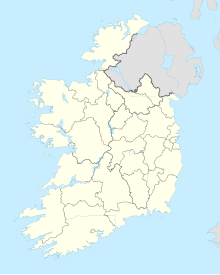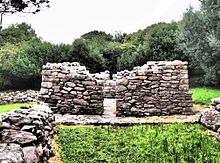Killelton Oratory
Coordinates: 52 ° 13 ′ 41 ″ N , 9 ° 52 ′ 27.6 ″ W.
The restored ruin of the Killelton Oratory ( Irish Cill Eiltín ) is located in the west of the homonymous village ( desert ), in the Loch a Duin Valley, near Camp on the north side of the Dingle Peninsula in County Kerry in Ireland .
description
The interior of the oratory measures five meters in length and is about 3.5 meters wide. A feature is the base on the north and south walls; an arrangement that has several early oratorios. During the restoration in 1984, a perforated stone was found that is similar to the door hinge stone of the Gallarus Oratory , which was also restored . The destroyed oratorios by Raingiléis and Reask also had similar elements.
The restoration has changed the appearance of the overgrown plant for a few centuries. The height of the walls (between 1.1 and 1.9 m) was significantly increased during the reconstruction. The oratory is made of dry stone . The walls of an almost square enclosure, of which there are sparse remains, enclose two other rectangular buildings.
history
The first mention of this place appeared in the Ulster Archaeological Journal in 1860. The author of the report notes the local belief that beneath it lies the grave of the Milesian princess, called Fas or Fais. In 1898 Mary Hickson reported more details in the Journal of the Royal Society of Antiquaries of Ireland. The area between Killelton, Caherconree and Maumnahaltora was known as Glenfais (Fais' Valley) for 20 to 30 centuries. However, both and the local historian Doncha Ó Conchúir place the mythical tomb of Fais two miles further away on the west bank of the Finglas River. A step stone bridge leads through the Finglas River to the point.
Killelton Church was added to the list of National Monuments of Ireland .
Legend
The nearby "Madman's Stone", a portlaun , shows the imprint of a palm that is said to come from drinkers who propped themselves up here. It is said about him: The porthole in this stone was filled with milk by the fairies and people went crazy when they roamed the valley at night and drank from it. The legend refers to the goddess Oimelg (sheep's milk), who was a predecessor of the Brigid .
The Killelton Stone
There are several bowls on the nearby stone, but they are difficult to see because of the erosion. The upper part of the stone is divided along a west-east line by a natural ridge and artificial processing. 36 cups have been picked above and below the line, some of which are oval.
literature
- Steve MacDonogh: The Dingle Peninsula: History, Folklore and Archeology . Brandon, 1993 ISBN 0-86322-159-9
- Jürgen E. Walkowitz: The megalithic syndrome. European cult sites of the Stone Age (= contributions to the prehistory and early history of Central Europe. Vol. 36). Beier & Beran, Langenweißbach 2003, ISBN 3-930036-70-3 .

